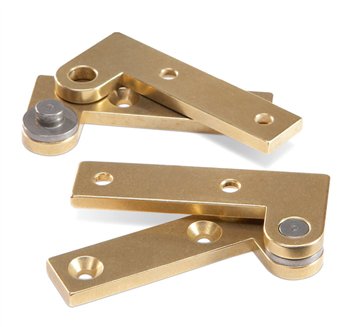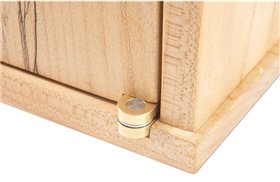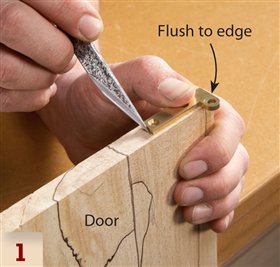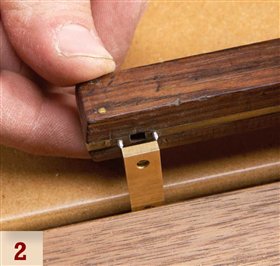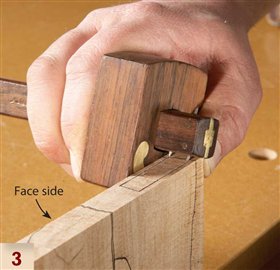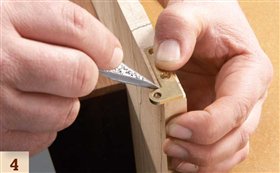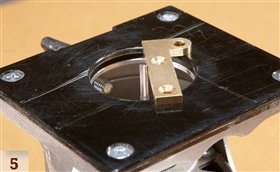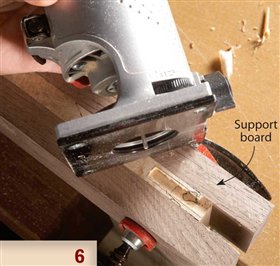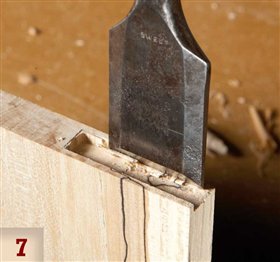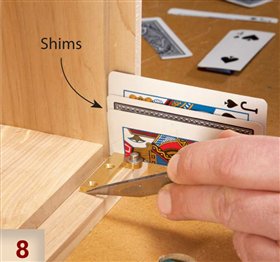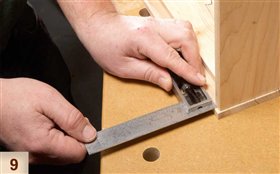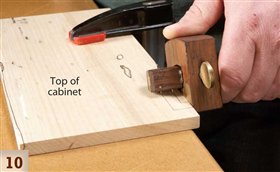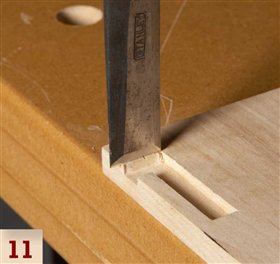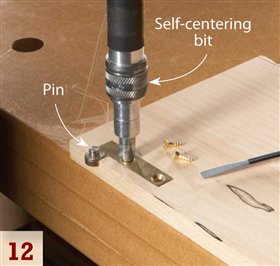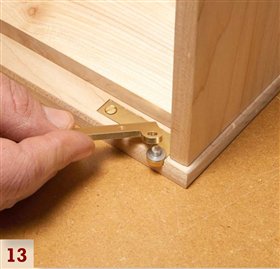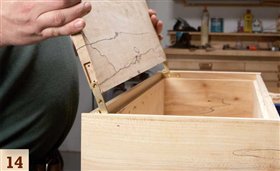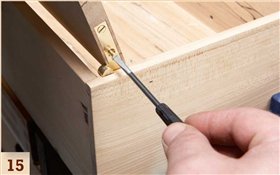|
Small and discreet, knife hinges
lend a tidy, refined look to your project.
They’re ideal for a small cabinet if you
want the hinge hardware to virtually
disappear.
Knife hinges are also a hallmark of
good craftsmanship. Precisely laying
out their mortises takes patience and
a steady hand. You’ll be using some
classic hand tools, such as a marking
knife, a marking gauge and a few sharp
chisels. Th ere are no short cuts, and
practically no room for adjustment once
the mortises are cut.
Don’t let me scare you, though. If
you follow the steps outlined below, you
really can’t go wrong.
There are two styles of knife hinges:
straight and off set. Straight hinges are
used for overlay doors. Off set hinges let
a door swing out farther than straight
hinges, so they’re used for cabinets with
inset doors. I’ll be showing you how to
install off set hinges.
Before you start
All knife hinges are composed of two parts, or “leaves,”
that are easy to separate. One leaf is mortised into the
top and bottom edges of the cabinet’s door; the mating
leaf is mortised into the cabinet itself. It’s extremely difficult
to cut the mortises in the cabinet after the cabinet
is assembled. Your best bet is to hold off gluing the cabinet
together until you’ve completed all the mortising.
Begin by temporarily clamping the cabinet together.
Cut the door so that it’s a snug fit in the opening.
Next, determine the size of the gap you’ll want all
around the door. This isn’t an arbitrary measurement:
It’s determined by the gap between the two leaves of your
hinges, which is the thickness of the washer between the
leaves. Make shims that are the same thickness as the
washer. (I use a stack of cut-up playing cards. The washers
on my hinges were three cards thick.)
Carefully cut the door smaller, ending up with gaps
that are the same size on all four sides. I use a hand plane
when I get close to final size in order to avoid taking off
too much wood.
Door mortises first
The most accurate way to lay out the mortises is with a
marking knife and a marking gauge. Making shallow
grooves in the wood, these tools allow you to positively
register a chisel in a way that a pencil line cannot.
We’ll start with the door mortises, because the thickness
of the door determines the position of the hinge.
Clamp the door in a vise at a comfortable working height.
Position one leaf of the hinge on the door’s top or bottom
edge, so that the hinge is flush with the door’s edge.
Using a marking knife, mark the hinge’s end with a short,
shallow cut (Photo 1). Locate your knife in the cut, slide
a small square against the blade and scribe a line all the
way across.
Adjust a mortising gauge to the width of the hinge
(Photo 2; see Sources, below). You could also use a
marking gauge with a single pin or a single wheel, but
you’ll have to re-adjust it for each side of the mortise.
Adjust the gauge’s head so that the mortise will be centered
on the door. Test the setting on a piece of scrap the
same thickness as your door. When you’ve got the setting
right, scribe the mortise’s long sides (Photo 3).
Hold the hinge in place again and mark its off set arm
(Photo 4). As before, make a short cut first, then scribe the
line using a square.
The best way to remove most of the waste inside the
mortise is to use a 1/8” bit in a laminate trimmer or other
small router (see Sources). You could chop the mortise
with a chisel, but it’s risky. The walls of the mortise are
usually very thin and could easily split out. The depth of
the mortise should exactly match the thickness of one
hinge leaf. To set the bit’s depth of cut, turn your router
upside down, set a hinge leaf on the router’s base and slide
the leaf against the bit (Photo 5).
Rout the mortise (Photo 6). Clamp boards on both
sides of the door to keep your router from wobbling.
Extend the boards about 1” past the edge of the door to
ensure that the router is steady before you start cutting.
Rout freehand, staying about 1/32” inside the lines. You’ll
find that a 1/8” bit is very easy to control. Don’t push too
hard, though; this bit is fragile.
Clean up the mortise by gradually paring to the layout
lines. Use a wide chisel on the long sides to make straight,
crisp edges (Photo 7). I use a 1-1/4” butt chisel.
Cabinet mortises second
The cabinet is still clamped together, right? The first step
in marking the cabinet mortises is the same as marking
the door mortises: Begin with one end of the hinge. Here,
though, the hinge won’t be flush with the cabinet’s side,
because you have to allow for a gap between the door and
the cabinet. On my cabinet, the gap is the thickness of
three playing cards (the thickness of the washer between
the hinge leaves). Place the cards, or whatever shims
you’re using, between the hinge and the side of the cabinet
(Photo 8). Then mark the opposite end of the hinge, shallow
and short at first, followed by a squared line.
If the door is set back from the cabinet’s top and bottom,
use a square to measure this distance (Photo 9). (If
your door is flush with cabinet’s top, bottom and sides,
skip this step.) Slide your mortising gauge’s head further
away from the pins by this distance. Test your new setting
on scrap to make sure it’s right.
Now you can remove the clamps and disassemble the
cabinet. Scribe the mortise’s long sides on the cabinet’s top
and bottom (Photo 10). Lay the hinge in place, then mark
its opposite end and the off set arm. Scribe these lines, as before, using a square and marking knife. Rout the mortises.
Clean them up using a chisel (Photo 11 ).
Next, set the hinge leaves in the cabinet mortises and
pre-drill pilot holes for the screws (Photo 12). I use a selfcentering
bit for this operation to ensure that the holes
are perfectly aligned. That’s not so critical for the cabinet
mortises, because the hinge is trapped, but centered holes
are critical for the door mortises, where the hinge could
slide.
If you’re using brass screws, “thread” the pilot holes
first with steel screws of the same size, then install the
brass screws. Use a screwdriver, not a drill/driver, to avoid
stripping out or breaking the screws.
You may want to re-assemble the cabinet one more
time, just with clamps, to make sure the door hangs right.
(Or if you’re feeling confident, glue it!) Reassemble the
hinges by slipping the door leaves back onto the pins of
the cabinet leaves (Photo 13).
Lay the cabinet on its back and slide the door onto
the hinges (Photo 14). You might need some help here,
because you can’t see both hinges at the same time. Once
the door is in place, pre-drill pilot holes for the screws,
then install the screws (Photo 15).
Stand up the cabinet and check the door’s fit and gaps.
Make any necessary adjustments using a hand plane or
sanding block.
|
|
Click any image to view a larger version.

Knife hinges go undercover when installed—you can barely see
them. They’re perfect for the type of cabinets whose hardware
shouldn’t distract from the piece’s design or the beauty of the wood.

1. Lay out the door mortises first. Position
one hinge leaf flush with the door’s edge,
then scribe across the end of the hinge.

2. Set the pins on a mortising gauge to the
width of the leaf.

3. Scribe the mortise from the face side of
the door.

4. Scribe the hinge’s offset arm, again using the hinge itself as a
template.

5. Adjust the height of a 1/8” router bit to match the thickness of
the leaf.

6. Rout about 1/32” shy of the mortise’s layout
lines. Clamp two support boards to the door
to prevent the router from tipping.

7. Pare to the lines using a wide chisel. Take
thin shavings, so you don’t split out the
mortise’s thin walls.

8. Temporarily assemble your cabinet, then
lay out its hinge mortises. Place shims
next to the hinge to determine the gap
between the door and cabinet side.

9. If the sides and door of your cabinet are set back, measure this
distance. Move the head of the mortising gauge away from the
pins by the same amount.

10. Disassemble the cabinet, then scribe mortises on the pieces
above and below the door. Remove most of the waste using
your router.

11. Clean up the sides of the mortise with a
chisel.

12. Place the leaves that have pins in the cabinet
mortises. Pre-drill the screw holes using a selfcentering
bit. Install the screws by hand.

13. Re-assemble the cabinet and add the
other hinge leaves.

14. Slide the door onto the hinges.

15. Install the screws in the door leaves. If everything fits right, glue
the cabinet together.
|



